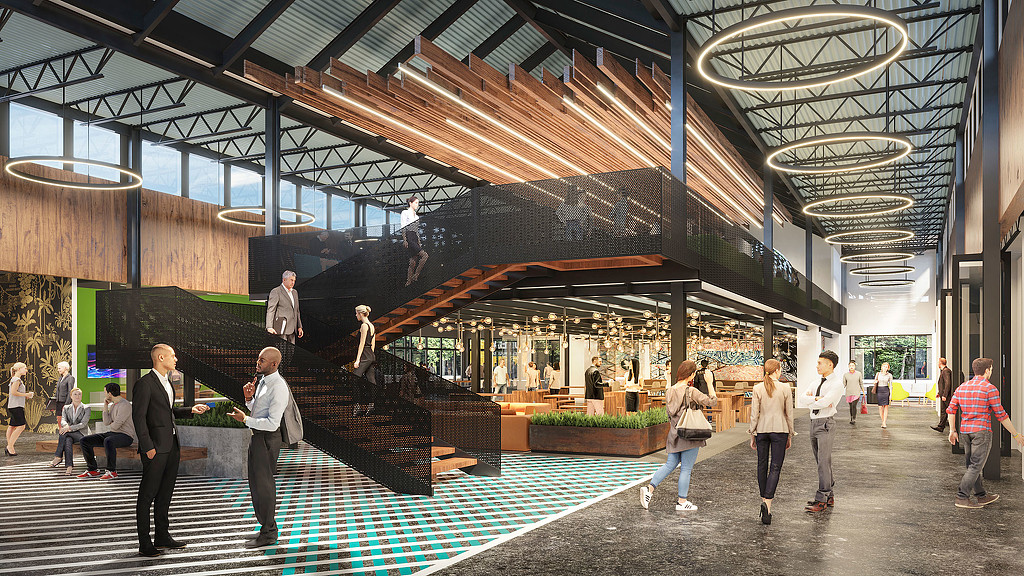5 ‘Out of the Box’ Strategies for the Retail Real Estate Market
June 23, 2020 | By Barry Bourbon
Editor’s Note: This post is part of our ongoing exploration of how design is responding to the COVID-19 pandemic.
COVID-19 has dramatically altered the retail landscape — and possibly the real estate market along with it. As Bloomberg reports, “As many as 25,000 U.S. stores could close permanently this year after the coronavirus pandemic devasted an industry where many mall-based retailers were already struggling.” Recently, JCPenney, J.Crew, and Neiman Marcus have all declared bankruptcy, and well-known retailers such as Pier 1, Sears, Nordstrom, and Macy’s, have all announced multiple store closures. At this point, developers and cities are face-to-face with the looming reality that there will be thousands of square feet of available space in prime locations throughout their communities. What should they do with it?
Behind the boarded-up storefronts, inside the vacant department stores, and on the empty parking lots, there may be an opportunity to repurpose the square footage into something different. Instead of focusing solely on transactional retail stores, cities and developers should consider addressing community needs and services.
Here are five recommendations for retail reuse to align under-utilized real estate assets with growing community needs:
1. Reimagine retail centers as multi-family housing developments.A persistent shortage of affordable housing exists in every U.S. state. Increasing access to affordable housing aids in economic growth. According to the National Low Income Housing Coalition, “each dollar invested in affordable housing boosts local economies by leveraging public and private resources to generate income — including resident earnings and additional local tax revenue — and supports job creation and retention.” Many retail centers are located near major thoroughfares or public transit corridors, making these sites logical locations for new multi-family housing developments.
2. Transform malls into community college campuses.Continuing demands are increasing for community colleges to support satellite locations for next generation workforce training. By utilizing existing mall infrastructure, we could make higher education more accessible to the community. The advantage of co-located restaurants, retail, and fitness centers would bring a campus appeal to the student’s experience. Perhaps small business incubators could leverage adjacent foot traffic and visibility to enable recent graduates to become the latest entrepreneurs in their communities.
3. Extend the office to workplace meeting hubs.The en masse shift to remote work is likely to continue after this pandemic. As the trend continues, it may not be practical to replicate certain functions and activities online or in one’s home office. According to Gensler’s new Work From Home (WFH) Survey, the most important reasons employees see for coming into the office include meetings, socializing, connecting with colleagues, and building community. To meet this desire for in-person connection, workplace meeting hubs may emerge as centers for connectivity. Enhanced meeting facilities with advanced video conferencing, virtual white boards, IT assistance, and shipping services may become a vital local resource. Convenient locations at previous retail settings within a few minutes of your home could help workers avoid crowded mass transit and lengthy commute times.
4. Bring healthcare to consumers through localized “health hubs.”Healthcare in today’s cities is becoming more distributed and more accessible as health systems extend their reach to places in communities where people can connect and stay healthy outside of a hospital. Deloitte Insight’s article, “Forces of Change, the Future of Health,” anticipates that in the next 20 years we will see the emergence of “localized health hubs,” brick- and-mortar facilities that offer multiple services — from preventative care, to education, wellness, and treatment. While consumers might still seek primary or specialty care from healthcare providers, local hubs that have been established in retail settings could connect patients and practitioners through virtual care or telehealth — a market that could rise to more than one billion visits this year.
5. Repurpose vacant retail as senior housing.JLL’s 2019 Seniors Housing Survey estimates that between 5% and 8% of baby boomers — as many as 6 million people — are expected to transition to senior apartments over the next decade. As the demand for senior housing grows, it makes sense that residents will be drawn to new developments with desirable, amenity-rich social activities and entertainment along with fitness and healthcare offerings. Large big-box retail stores could be well-positioned for this kind of transition. In fact, a student design team at Oklahoma State University led by Assistant Professor Dr. Emily Roberts has developed a prototype to repurpose a vacant, 800,000-square-foot mall into a continuing care retirement community incorporating independent living, assisted living, memory care, a medical center, and workforce housing.
For these strategies to succeed, existing regulations and current business models will need to be modified. We can assist with the transformation by bringing non-traditional partners together to help envision these redevelopment opportunities. While landlords and developers are willing to spark change, they can’t do it alone. Cities are understandingly hesitant to give up sales tax revenues; however, planning departments need to consider the option of rezoning for evolving community needs. In order to adapt to changing economic conditions and provide equitable and inclusive solutions, permitting agencies need to help support adaptive reuse opportunities and modular construction approval protocols.
In order to determine a successful path forward, we must ultimately engage the communities in which these underutilized assets exist. By hearing from community leadership, along with retail center landlords and forward-thinking developers, we can craft strategies for the future of these underperforming assets that address inequities and better align with community needs.
For media inquiries, email .

